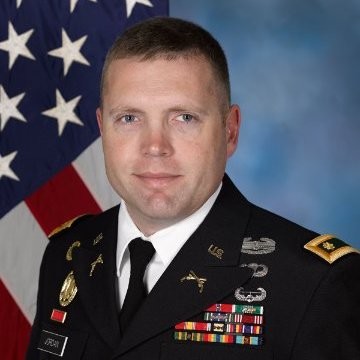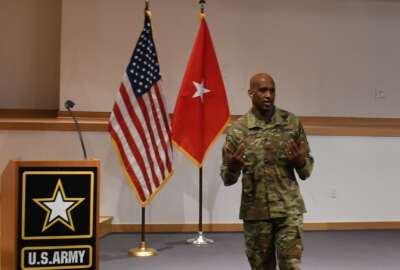With UNO, Army intends to stop battling its own network
Lt. Col. Keith Jordan, in the Army’s PEO-C3T, said a recent draft solicitation is a key step in the Unified Network Operations (UNO) initiative.
The Army has a plan to no longer “fight the network.”
Through the Unified Network Operations (UNO), initiative, the Army wants to create an agile, software-defined network that is easy to set up and use. This is the opposite of what soldiers currently must deal with then setting up a tactical network that requires on-premise hardware, cables and unique knowledge and skillsets.
The Army is laying the groundwork for this new network set up under UNO in a new draft request for proposals that Lt. Col. Keith Jordan, the product manager for Tactical Cyber and NetOps, in the Army’s Program Executive Office Command Control Communications-Tactical (PEO-C3T) said will bring efficiency, ease of use and, most importantly, meet the needs of commanders more readily.

“There’s a time component of how long it takes to make the network operate. That’s a concern. But also, it’s a manpower issue. It’s specialized training and skills that our signal soldiers are required to have in order to make all these different components of network work, both from a hardware perspective, a cabling, a software interoperability issue perspective and troubleshooting. So there’s a lot of different factors that the soldiers have to go through to make the network work,” Jordan said in an exclusive interview with Federal News Network. “When they are having to do those tasks across multiple items, one-by-one, it does take a lot more time. And depending on a unit, you’re going to always have a degree of soldiers that have the right requisite training and the right requisite experience. So there’s always a little bit of inefficiency built into that model. What we’re looking to do through this is to really improve that inefficiency, and make it much more a much simpler task for those soldiers, especially if we’re not fully manned that at each unit to do that mission.”
PEO-C3T has been leading the UNO effort for the better part of two years and the draft RFP is the second piece of a three-pronged effort to create this new software-defined network.
Jordan said the draft solicitation, for which responses are due by July 17, will help inform its long term plans to bring in commercial technologies and take advantage of cloud services. PEO-C3T expects to issue a final RFP for this multiple award indefinite delivery, indefinite quantity contract in early 2025 and make awards in early 2026.
In the meantime, Jordan said the Army will soon award “several” other transaction agreements (OTAs) to examine prototypes of what UNO may look like.
“The Army acquisition executive last year decided that UNO would utilize the software acquisition pathway. This is a new pathway under the adaptive acquisition framework that really is focused on how we manage, contract and deliver software capability to the Army. It’s different than what we might typically see under the some of the older pathways. This really is a revolution of thinking in the Army of how we recognize that software is different than hardware and it needs to be procured differently,” he said on Ask the CIO. “Really, what that does is it allows us to deliver capability incrementally versus like a big bang where the product is done all at once. We recognize that this will not be done right off the bat, you’ll get updates to the capability over time and each time we make an update, the capability will get more and more mature, more and more capable. The whole idea is we’re able to rapidly make these updates versus in the past where it may take a really long time to make an update. We want to update very often based on feedback in whatever theater we might be operating in.”
Army testing prototypes through OTA
Through the OTA process, Jordan said vendors will demonstrate SDN capabilities that can bring together several disparate systems and handle a large number of users over a several month period.
He said the vendors will demonstrate the SDN capabilities in the lab and in the field so soldiers can provide real-time feedback and the contractors can add or change the network as required.
Jordan said “usability” and “simplicity” will be key concepts that the Army wants to see in the prototypes.
“We think by doing that we’re going to really get down to a good vendor, and then following that, we’re going to pursue a FAR-based contract that will allow a lot more vendors to get in the mix and be able to deliver various capabilities,” he said. “We don’t know how many vendors we’re going to end up with so that’s why the window [for timing] is a little bit difficult. But we think between late 2024 and 2025, we’ll be able to complete that [OTA award] process. Then as we go into the prototype phase, the idea would be that’s a little bit of a longer phase because there’ll be a downselect. We’re not going to take the same amount of vendors from the lab to the field. We’re going to take those vendors out to the field and that’ll be a little bit longer because what we do want to do is see their agile development process and we want to be able to see as a soldier provides feedback to a particular company, we want to see him make the changes that we’re looking for. It’s not just about the technology, it’s also going to be about the company’s ability to manage the process.”
Jordan said the network of the future will depend on agile and DevSecOps process, where signal soldiers will not have to have special skillsets.
The future network also will enable commanders to make faster and better decisions as data will be easier to get and use.
“We’ve had to fight the network for a long time. This will help us be able to get the network up and running efficiently, tailored to our mission needs and operationalize it,” Jordan said. “For industry, there’s going to be lots of opportunities inside UNO to deliver unique and value added capabilities to the network. We’re really excited because there is so many opportunities for businesses, both small and large, to deliver capability inside the network, around things that we haven’t even thought of yet that we may want. As long as our vendors are able to operate in a modular open system approach, and that we’re able to integrate capability into that architecture in a rapid and easy to do methodology, we’re really going to be successful.”
Copyright © 2024 Federal News Network. All rights reserved. This website is not intended for users located within the European Economic Area.
Jason Miller is executive editor of Federal News Network and directs news coverage on the people, policy and programs of the federal government.
Follow @jmillerWFED








